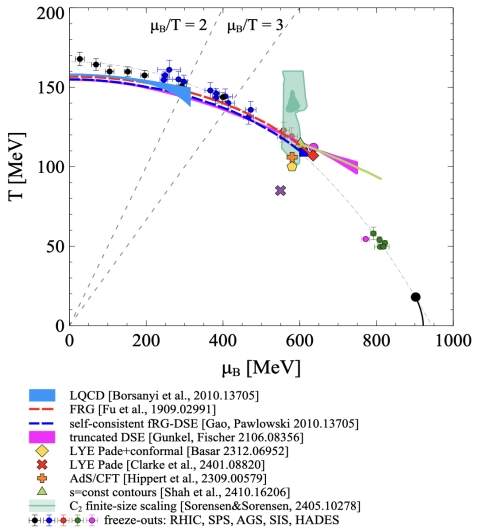The QCD Critical Point: Are We There Yet?
INT-25-3a

Note to attendees: After reviewing the applications and evaluating the proposed contributions to the program, the division of subjects became a little different than the one stated below. Now, both Week 1 and Week 2 will feature fluctuations.
In Week 1, we will concentrate on lower-order cumulants and understanding the fluctuations as measured in experiment. As previously planned, Week 1 will also feature discussions of other experimental observables such as flow, HBT, and cluster production.
In week 2, the discussion of fluctuations will put more stress on higher-order cumulants as well as related theoretical developments. Additionally, Week 2 will also cover QCD CP predictions, stochastic hydrodynamics, and insights from studies of neutron stars
EVENT CODE: INT-25-3a
OVERVIEW
Among past, current, and planned heavy-ion collision experiments, the Beam Energy Scan (BES) program at the Relativistic Heavy Ion Collider (RHIC) is uniquely poised to enable a breakthrough discovery: uncovering the existence and location of the QCD critical point (CP) in the phase diagram of strongly-interacting matter.
Phase I of the BES already revealed several measurements consistent with early predictions for a CP and/or softening in the equation of state (EOS), including flow observables and HBT measurements. Recently, after the completed Phase II of BES provided unprecedented statistics, the STAR collaboration has begun to publish improved and extended measurements of key observables which could further reveal whether a CP can be located using the RHIC data. Meanwhile, theoretical work has substantially advanced the case for the existence of a QCD CP, with first-principles-based predictions lying within the reach of the BES.
As these measurements and rigorous theoretical results are becoming available, it is time to ask the following questions:
- Does a theoretical consensus on predictions for the location of the CP exist and if it does, does it change our understanding of data?
- Which of the experimental analyses, in conjunction with theoretical efforts, are the most revealing?
- What key properties do we need to observe and what alternative explanations do we need to rule out to arrive at a clear interpretation of the experimental data?
- Are we making the best use of the existing theoretical frameworks to help uncover the QCD phase diagram?
PROGRAM FORMAT
This program will address the above questions by reviewing and synthesizing experimental and theoretical efforts to date, identifying necessary remaining components in the quest to pin down the location of the QCD CP, and pursuing a community-driven discovery standard.
To that end, the program will focus on observables that have been predicted to provide a signal for the QCD CP:
WEEK 1:
- Observables reflecting the collective evolution and properties of the system, such as the mean transverse momentum and flow, which are sensitive to the EOS and, therefore, the CP due to their origin in the pressure gradients within the collision region.
- Femtoscopic correlations, which allow one to extract the three-dimensional measurement of the size of the system that itself depends on the EOS.
WEEK 2:
- Cumulants of conserved charge fluctuations, which are predicted to behave in a particular way in the vicinity of the CP, with a particular emphasis on lower-order cumulants that are significantly easier to both measure and calculate in models.
- Yields of deuterons, tritons, and other light clusters, which are sensitive to baryon-baryon correlations and thus provide a signal for critical behavior which enhances fluctuations.
Additionally, the applicants are encouraged to suggest other observables they deem important to discuss.
For each program week, we plan to have two organized sessions per day. One will be in the morning and will typically feature up to two 30- to 45-minute presentations, focusing on latest developments and persistent challenges, along with ample time for discussion. Another session will take place in the afternoon and will concentrate on further discussions related to the results or problems presented in the morning.
We are looking forward to applications from members of the nuclear physics community working on topics related to the program. We particularly strongly encourage researchers at early stages of their careers to apply. Please don’t hesitate to contact any of the organizers with your questions or concerns.
